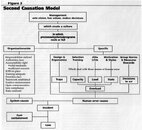Bob and Julie,
First, my condolence to Julie for the loss of Jennifer. This is terribly tragic, and unnecessary.
Now, let me do a bit more analyses. As has been stated, pairing two inexperienced divers together is a not good; it can lead to both having problems, which indeed happened. Before I do that, I will put an accident model down that was developed by a Safety Professional named Dan Peterson. This analysis will come in sections, as ScubaBoard has a tendency of loosing text if you go away too long, so be patient.
Peterson, Dan, Ph.D., P.E., CSP, "Human Error, A closer look at Safety's next frontier",
Professional Safety Magazine, December 2003,
www.asse.org.
If you look at this flow diagram, there are many areas which are impacted by this accident. Let's look at them one at a time:
Management, sets vision, has values, makes decisions
In this case, it appears that this boat was undermanned. It had a captain, and no one else supervising the dives. There was an instructor, but that individual was preoccupied with his/her students. There appears not to have been a Divemaster on board. So far as the vision and values, it appears that the only vision was to make money for the boat.
which creates a culture
What kind of culture was aboard this boat. Was it truly a safety culture? I don't think so. It appears that it was a boat that carried the divers to the water to dive, and maybe assisted them getting out of the water. That's all.
in which processes/systems/programs work or fail
It appears that there was no actual system or process to ensure the safety of the divers on this boat. A good Divemaster would have picked up on Jennifer's reservations. Once expressed, that should be a red flag. There was no system to ensure that inexperienced divers were not paired up with each other either. These were systems failures on the management of the boat/dive shop.
Organizationwide
Look at the list on the left of this diagram. "Responsibilities defined", "Authorities clear", "Accountability tight"...I don't see anything resembling these for this boat.
SOPs in place! Standard Operating Procedures (SOPs) are vital in an emergency. Banging on a ladder to get people back on board may be an emergency procedure, but I did not see that it was briefed at all.
Training adequate! Neither diver was adequately trained for this dive.
Priorities clear, and teamwork established--how can you have teamwork without a team?
Positive reinforcement? Dan Peterson is referring to reinforcing safe procedures. The culture on this boat was to reinforce unsafe procedures so the boat could gain another diver.
Open communications; communications was a problem, and apparently was not discussed in the pre-dive briefing.
Law compliance is a minimal standard.
The risks were not assessed at all.
I'll have more on the Specific causes in the flow diagram later tonight; it's time to break for supper.
John C. Ratliff (SeaRat), CSP, CIH, MSPH
John is a Certified Safety Professional, Certified Industrial Hygienist, and has his Master of Science in Public Health, with an emphasis on safety and industrial hygiene. John is also an ex-NAUI instructor (#2710), ex-USAF Pararescueman, and has been actively diving since 1959. He writes regularly on the Vintage Equipment portion of ScubaBoard.






